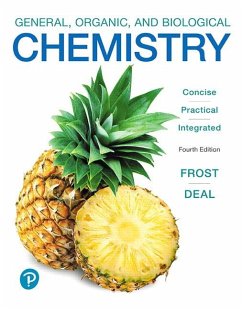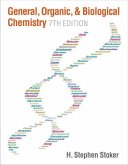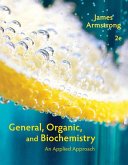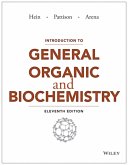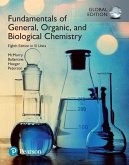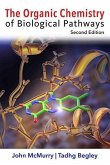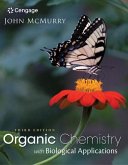- Gebundenes Buch
- Merkliste
- Auf die Merkliste
- Bewerten Bewerten
- Teilen
- Produkt teilen
- Produkterinnerung
- Produkterinnerung
For courses in General, Organic, and Biological Chemistry (1 - Semester) An integrated and applied approach to General, Organic, and Biological Chemistry General, Organic, and Biological Chemistry strengthens the evidenced strategy of integrating general, organic, and biological chemistry for a focused introduction to the fundamental connections between chemistry and life. The streamlined approach establishes a clear path through the content over a single semester. The text integrates essential topics more effectively than any text on the market, covering core concepts in each discipline in…mehr
Andere Kunden interessierten sich auch für
![General, Organic, and Biological Chemistry General, Organic, and Biological Chemistry]() H. Stephen Stoker (Weber State University)General, Organic, and Biological Chemistry121,99 €
H. Stephen Stoker (Weber State University)General, Organic, and Biological Chemistry121,99 €![General, Organic, and Biochemistry General, Organic, and Biochemistry]() James Armstrong (City College of San Francisco)General, Organic, and Biochemistry407,99 €
James Armstrong (City College of San Francisco)General, Organic, and Biochemistry407,99 €![Introduction to General, Organic, and Biochemistry Introduction to General, Organic, and Biochemistry]() Morris Hein (Mount San Antonio College)Introduction to General, Organic, and Biochemistry357,99 €
Morris Hein (Mount San Antonio College)Introduction to General, Organic, and Biochemistry357,99 €![Fundamentals of General, Organic and Biological Chemistry in SI Units Fundamentals of General, Organic and Biological Chemistry in SI Units]() John McmurryFundamentals of General, Organic and Biological Chemistry in SI Units111,99 €
John McmurryFundamentals of General, Organic and Biological Chemistry in SI Units111,99 €![The Organic Chemistry of Biological Pathways The Organic Chemistry of Biological Pathways]() John E. McMurryThe Organic Chemistry of Biological Pathways120,99 €
John E. McMurryThe Organic Chemistry of Biological Pathways120,99 €![Organic Chemistry with Biological Applications Organic Chemistry with Biological Applications]() John McMurry (Cornell University)Organic Chemistry with Biological Applications391,99 €
John McMurry (Cornell University)Organic Chemistry with Biological Applications391,99 €![The Penguin Dictionary of Chemistry The Penguin Dictionary of Chemistry]() D W A SharpThe Penguin Dictionary of Chemistry24,99 €
D W A SharpThe Penguin Dictionary of Chemistry24,99 €-
-
-
For courses in General, Organic, and Biological Chemistry (1 - Semester) An integrated and applied approach to General, Organic, and Biological Chemistry General, Organic, and Biological Chemistry strengthens the evidenced strategy of integrating general, organic, and biological chemistry for a focused introduction to the fundamental connections between chemistry and life. The streamlined approach establishes a clear path through the content over a single semester. The text integrates essential topics more effectively than any text on the market, covering core concepts in each discipline in just 12 comprehensive chapters. With the 4th Edition, authors Laura Frost and Todd Deal apply their knowledge and experience in the science of learning to incorporate research and best practices based on how students learn. A stronger applied focus provides practical connections and applications, showing both allied-health and non-science majors how to use their understanding of chemistry in future health professions and in their everyday lives.
Hinweis: Dieser Artikel kann nur an eine deutsche Lieferadresse ausgeliefert werden.
Hinweis: Dieser Artikel kann nur an eine deutsche Lieferadresse ausgeliefert werden.
Produktdetails
- Produktdetails
- Verlag: Pearson Education (US)
- 4 ed
- Seitenzahl: 560
- Erscheinungstermin: 11. Januar 2019
- Englisch
- Abmessung: 223mm x 285mm x 28mm
- Gewicht: 1438g
- ISBN-13: 9780134988696
- ISBN-10: 0134988698
- Artikelnr.: 57175516
- Herstellerkennzeichnung
- Libri GmbH
- Europaallee 1
- 36244 Bad Hersfeld
- gpsr@libri.de
- Verlag: Pearson Education (US)
- 4 ed
- Seitenzahl: 560
- Erscheinungstermin: 11. Januar 2019
- Englisch
- Abmessung: 223mm x 285mm x 28mm
- Gewicht: 1438g
- ISBN-13: 9780134988696
- ISBN-10: 0134988698
- Artikelnr.: 57175516
- Herstellerkennzeichnung
- Libri GmbH
- Europaallee 1
- 36244 Bad Hersfeld
- gpsr@libri.de
About our authors LAURA FROST is a Professor of Chemistry at Florida Gulf Coast University and Director of the Whitaker Center for Science, Technology, Engineering, and Mathematics (STEM) Education. She received a bachelor's degree in chemistry from Kutztown University and her Ph.D. in chemistry with a biophysical focus from the University of Pennsylvania. She has been teaching chemistry in higher education for over 20 years and continues to teach chemistry to students in the health professions. Professor Frost is actively engaged in the teaching and learning in all STEM subjects, particularly chemistry, and uses a guided inquiry approach in her classes. She is very involved in the scholarship of teaching and learning and has demonstrated that the use of inquiry-based activities increases student learning in her one-semester chemistry course for health professionals. Dr. Frost is a member of the American Chemical Society and its Chemical Education division. A member of the University System of Georgia faculty Hall of Fame, Dr. Frost has been honored on more than one occasion for her teaching excellence. Her writing has also been recognized, and in 2014, she was elected to the governing council of the Textbook and Academic Authors Association. Dr. Frost is engaged in STEM education reform through evidence-based teaching and learning at all levels (K16), as well as through community outreach. She was principal investigator of a successful NSF grant that provides professional development for faculty in evidence-based practices in STEM. She has spoken and attended numerous conferences and workshops on this topic. TODD DEAL received his B.S. degree in chemistry in 1986 from Georgia Southern College (now University) in Statesboro, Georgia, and his Ph.D. in chemistry in 1990 from The Ohio State University. students in the health professions. An award-winning educator, Dr. Deal has received numerous awards for excellence in teaching and in service, and was named Professor of the Year by the students of Georgia Southern. Prof. Deal has also been recognized by Project Kaleidoscope for his innovative teaching in the sciences. Professor Deal is a member of American Chemical Society and its Chemical Education division. He is also a member of the Omicron Delta Kappa National Leadership Honor Society, the International Leadership Association, and the Association of Leadership Educators. Dr. Deal's teaching interests span from chemistry and the hard sciences to the soft, human sciences of leadership and leadership development.
1. Chemistry Basics - Matter and Measurement
1.1 Classifying Matter: Pure Substance or Mixture
1.2 Elements, Compounds, and Periodic Table
1.3 How matter Changes
1.4 Math Counts
1.5 Matter: The "Stuff" of Chemistry
1.6 Measuring Matter
2. Atoms and Radioactivity
2.1 Atoms and Their Components
2.2 Atomic Number and Mass Number
2.3 Isotopes and Atomic Mass
2.4 Radioactivity and Radioisotopes
2.5 Nuclear Equations and Radioactive Decay
2.6 Radiation Units and Half-Lives
2.7 Medical Applications for Radioisotopes
3. Compounds - How Elements Combine
3.1 Electron Arrangements and the Octet Rule
3.2 In Search of an Octet, Part 1: Ion Formation
3.3 Ionic Compounds- Electron Give and Take
3.4 In Search of an Octet, Part 2: Covalent Bond Formation
3.5 The Mole: Counting Atoms and Compounds
3.6 Getting Covalent Compounds into Shape
3.7 Electronegativity and Molecular Polarity
4. Introduction to Organic Compounds
4.1 Representing the Structures of Organic Compounds
4.2 Alkanes: The Simplest Organic Compounds
4.3 Families of Organic Compounds- Functional Groups
4.4 Nomenclature of Simple Alkanes
4.5 Isomerism in Organic Compounds
5. Chemical Reactions
5.1 Thermodynamics
5.2 Chemical Reactions: Kinetics
5.3 Overview of Chemical Reactions
5.4 Oxidation and Reduction
5.5 Organic Reactions: Condensation and Hydrolysis
5.6 Organic Addition Reactions to Alkenes
6. Carbohydrates - Life's Sweet Molecules
6.1 Classes of Carbohydrates
6.2 Function Groups in Monosaccharides
6.3 Stereochemistry in Monosaccharides
6.4 Reactions of Monosaccharides
6.5 Disaccharides
6.6 Polysaccharides
6.7 Carbohydrates and Blood
7. States of Matter and Their Attractive Forces: Gas Laws, Solubility, and
Applications to the Cell Membrane
7.1 Gases and Gas Laws
7.2 Liquids and Solids: Predicting Properties Through Attractive Forces
7.3 Attractive Forces and Solubility
7.4 Dietary Lipids
7.5 Attractive Forces and the Cell Membrane
8. Solution Chemistry - Sugar and Water Do Mix
8.1 Solutions Are Mixtures
8.2 Formation of Solutions
8.3 Chemical Equations for Solution Formation
8.4 Concentration
8.5 Dilution
8.6 Osmosis and Diffusion
8.7 Transport Across
9. Acids, Bases, and Buffers in the Body
9.1 Acids and Bases- Definitions
9.2 Strong Acids and Bases
9.3 Chemical Equilibrium
9.4 Weak Acids and Bases
9.5 pH and the pH Scale
9.6 pKa
9.7 The Relationship Between pH, pKa, Drug Solubility, and Diffusion
9.8 Buffers and Blood- The Bicarbonate Buffer System
10. Proteins - Workers of the Cell
10.1 Amino Acids- The Building Blocks
10.2 Protein Formation
10.3 The Three-Dimensional Structure of Proteins
10.4 Denaturation of Proteins
10.5 Protein Functions
10.6 Enzymes - Life's Catalysts
10.7 Factors That Affect Enzyme Activity
11. Nucleic Acids - Big Molecules with a Big Role
11.1 Components of Nucleic Acids
11.2 Nucleic Acid Formation
11.3 DNA
11.4 RNA and Protein Synthesis
11.5 Putting It Together: The Genetic Code and Protein Synthesis
11.6 Genetic Mutations
11.7 Viruses
11.8 Recombinant DNA Technology
12. Food as Fuel - An Overview of Metabolism
12.1 How Metabolism Works
12.2 Metabolically Relevant Nucleotides
12.3 Digestion - From Food Molecules to Hydrolysis Products
12.4 Glycolysis - From Hydrolysis Production to Common Metabolites
12.5 The Citric Acid Cycle - Central Processing
12.6 Electron Transport and Oxidative Phosphorylation
12.7 ATP Production
12.8 Other Fuel Choices
1.1 Classifying Matter: Pure Substance or Mixture
1.2 Elements, Compounds, and Periodic Table
1.3 How matter Changes
1.4 Math Counts
1.5 Matter: The "Stuff" of Chemistry
1.6 Measuring Matter
2. Atoms and Radioactivity
2.1 Atoms and Their Components
2.2 Atomic Number and Mass Number
2.3 Isotopes and Atomic Mass
2.4 Radioactivity and Radioisotopes
2.5 Nuclear Equations and Radioactive Decay
2.6 Radiation Units and Half-Lives
2.7 Medical Applications for Radioisotopes
3. Compounds - How Elements Combine
3.1 Electron Arrangements and the Octet Rule
3.2 In Search of an Octet, Part 1: Ion Formation
3.3 Ionic Compounds- Electron Give and Take
3.4 In Search of an Octet, Part 2: Covalent Bond Formation
3.5 The Mole: Counting Atoms and Compounds
3.6 Getting Covalent Compounds into Shape
3.7 Electronegativity and Molecular Polarity
4. Introduction to Organic Compounds
4.1 Representing the Structures of Organic Compounds
4.2 Alkanes: The Simplest Organic Compounds
4.3 Families of Organic Compounds- Functional Groups
4.4 Nomenclature of Simple Alkanes
4.5 Isomerism in Organic Compounds
5. Chemical Reactions
5.1 Thermodynamics
5.2 Chemical Reactions: Kinetics
5.3 Overview of Chemical Reactions
5.4 Oxidation and Reduction
5.5 Organic Reactions: Condensation and Hydrolysis
5.6 Organic Addition Reactions to Alkenes
6. Carbohydrates - Life's Sweet Molecules
6.1 Classes of Carbohydrates
6.2 Function Groups in Monosaccharides
6.3 Stereochemistry in Monosaccharides
6.4 Reactions of Monosaccharides
6.5 Disaccharides
6.6 Polysaccharides
6.7 Carbohydrates and Blood
7. States of Matter and Their Attractive Forces: Gas Laws, Solubility, and
Applications to the Cell Membrane
7.1 Gases and Gas Laws
7.2 Liquids and Solids: Predicting Properties Through Attractive Forces
7.3 Attractive Forces and Solubility
7.4 Dietary Lipids
7.5 Attractive Forces and the Cell Membrane
8. Solution Chemistry - Sugar and Water Do Mix
8.1 Solutions Are Mixtures
8.2 Formation of Solutions
8.3 Chemical Equations for Solution Formation
8.4 Concentration
8.5 Dilution
8.6 Osmosis and Diffusion
8.7 Transport Across
9. Acids, Bases, and Buffers in the Body
9.1 Acids and Bases- Definitions
9.2 Strong Acids and Bases
9.3 Chemical Equilibrium
9.4 Weak Acids and Bases
9.5 pH and the pH Scale
9.6 pKa
9.7 The Relationship Between pH, pKa, Drug Solubility, and Diffusion
9.8 Buffers and Blood- The Bicarbonate Buffer System
10. Proteins - Workers of the Cell
10.1 Amino Acids- The Building Blocks
10.2 Protein Formation
10.3 The Three-Dimensional Structure of Proteins
10.4 Denaturation of Proteins
10.5 Protein Functions
10.6 Enzymes - Life's Catalysts
10.7 Factors That Affect Enzyme Activity
11. Nucleic Acids - Big Molecules with a Big Role
11.1 Components of Nucleic Acids
11.2 Nucleic Acid Formation
11.3 DNA
11.4 RNA and Protein Synthesis
11.5 Putting It Together: The Genetic Code and Protein Synthesis
11.6 Genetic Mutations
11.7 Viruses
11.8 Recombinant DNA Technology
12. Food as Fuel - An Overview of Metabolism
12.1 How Metabolism Works
12.2 Metabolically Relevant Nucleotides
12.3 Digestion - From Food Molecules to Hydrolysis Products
12.4 Glycolysis - From Hydrolysis Production to Common Metabolites
12.5 The Citric Acid Cycle - Central Processing
12.6 Electron Transport and Oxidative Phosphorylation
12.7 ATP Production
12.8 Other Fuel Choices
1. Chemistry Basics - Matter and Measurement
1.1 Classifying Matter: Pure Substance or Mixture
1.2 Elements, Compounds, and Periodic Table
1.3 How matter Changes
1.4 Math Counts
1.5 Matter: The "Stuff" of Chemistry
1.6 Measuring Matter
2. Atoms and Radioactivity
2.1 Atoms and Their Components
2.2 Atomic Number and Mass Number
2.3 Isotopes and Atomic Mass
2.4 Radioactivity and Radioisotopes
2.5 Nuclear Equations and Radioactive Decay
2.6 Radiation Units and Half-Lives
2.7 Medical Applications for Radioisotopes
3. Compounds - How Elements Combine
3.1 Electron Arrangements and the Octet Rule
3.2 In Search of an Octet, Part 1: Ion Formation
3.3 Ionic Compounds- Electron Give and Take
3.4 In Search of an Octet, Part 2: Covalent Bond Formation
3.5 The Mole: Counting Atoms and Compounds
3.6 Getting Covalent Compounds into Shape
3.7 Electronegativity and Molecular Polarity
4. Introduction to Organic Compounds
4.1 Representing the Structures of Organic Compounds
4.2 Alkanes: The Simplest Organic Compounds
4.3 Families of Organic Compounds- Functional Groups
4.4 Nomenclature of Simple Alkanes
4.5 Isomerism in Organic Compounds
5. Chemical Reactions
5.1 Thermodynamics
5.2 Chemical Reactions: Kinetics
5.3 Overview of Chemical Reactions
5.4 Oxidation and Reduction
5.5 Organic Reactions: Condensation and Hydrolysis
5.6 Organic Addition Reactions to Alkenes
6. Carbohydrates - Life's Sweet Molecules
6.1 Classes of Carbohydrates
6.2 Function Groups in Monosaccharides
6.3 Stereochemistry in Monosaccharides
6.4 Reactions of Monosaccharides
6.5 Disaccharides
6.6 Polysaccharides
6.7 Carbohydrates and Blood
7. States of Matter and Their Attractive Forces: Gas Laws, Solubility, and
Applications to the Cell Membrane
7.1 Gases and Gas Laws
7.2 Liquids and Solids: Predicting Properties Through Attractive Forces
7.3 Attractive Forces and Solubility
7.4 Dietary Lipids
7.5 Attractive Forces and the Cell Membrane
8. Solution Chemistry - Sugar and Water Do Mix
8.1 Solutions Are Mixtures
8.2 Formation of Solutions
8.3 Chemical Equations for Solution Formation
8.4 Concentration
8.5 Dilution
8.6 Osmosis and Diffusion
8.7 Transport Across
9. Acids, Bases, and Buffers in the Body
9.1 Acids and Bases- Definitions
9.2 Strong Acids and Bases
9.3 Chemical Equilibrium
9.4 Weak Acids and Bases
9.5 pH and the pH Scale
9.6 pKa
9.7 The Relationship Between pH, pKa, Drug Solubility, and Diffusion
9.8 Buffers and Blood- The Bicarbonate Buffer System
10. Proteins - Workers of the Cell
10.1 Amino Acids- The Building Blocks
10.2 Protein Formation
10.3 The Three-Dimensional Structure of Proteins
10.4 Denaturation of Proteins
10.5 Protein Functions
10.6 Enzymes - Life's Catalysts
10.7 Factors That Affect Enzyme Activity
11. Nucleic Acids - Big Molecules with a Big Role
11.1 Components of Nucleic Acids
11.2 Nucleic Acid Formation
11.3 DNA
11.4 RNA and Protein Synthesis
11.5 Putting It Together: The Genetic Code and Protein Synthesis
11.6 Genetic Mutations
11.7 Viruses
11.8 Recombinant DNA Technology
12. Food as Fuel - An Overview of Metabolism
12.1 How Metabolism Works
12.2 Metabolically Relevant Nucleotides
12.3 Digestion - From Food Molecules to Hydrolysis Products
12.4 Glycolysis - From Hydrolysis Production to Common Metabolites
12.5 The Citric Acid Cycle - Central Processing
12.6 Electron Transport and Oxidative Phosphorylation
12.7 ATP Production
12.8 Other Fuel Choices
1.1 Classifying Matter: Pure Substance or Mixture
1.2 Elements, Compounds, and Periodic Table
1.3 How matter Changes
1.4 Math Counts
1.5 Matter: The "Stuff" of Chemistry
1.6 Measuring Matter
2. Atoms and Radioactivity
2.1 Atoms and Their Components
2.2 Atomic Number and Mass Number
2.3 Isotopes and Atomic Mass
2.4 Radioactivity and Radioisotopes
2.5 Nuclear Equations and Radioactive Decay
2.6 Radiation Units and Half-Lives
2.7 Medical Applications for Radioisotopes
3. Compounds - How Elements Combine
3.1 Electron Arrangements and the Octet Rule
3.2 In Search of an Octet, Part 1: Ion Formation
3.3 Ionic Compounds- Electron Give and Take
3.4 In Search of an Octet, Part 2: Covalent Bond Formation
3.5 The Mole: Counting Atoms and Compounds
3.6 Getting Covalent Compounds into Shape
3.7 Electronegativity and Molecular Polarity
4. Introduction to Organic Compounds
4.1 Representing the Structures of Organic Compounds
4.2 Alkanes: The Simplest Organic Compounds
4.3 Families of Organic Compounds- Functional Groups
4.4 Nomenclature of Simple Alkanes
4.5 Isomerism in Organic Compounds
5. Chemical Reactions
5.1 Thermodynamics
5.2 Chemical Reactions: Kinetics
5.3 Overview of Chemical Reactions
5.4 Oxidation and Reduction
5.5 Organic Reactions: Condensation and Hydrolysis
5.6 Organic Addition Reactions to Alkenes
6. Carbohydrates - Life's Sweet Molecules
6.1 Classes of Carbohydrates
6.2 Function Groups in Monosaccharides
6.3 Stereochemistry in Monosaccharides
6.4 Reactions of Monosaccharides
6.5 Disaccharides
6.6 Polysaccharides
6.7 Carbohydrates and Blood
7. States of Matter and Their Attractive Forces: Gas Laws, Solubility, and
Applications to the Cell Membrane
7.1 Gases and Gas Laws
7.2 Liquids and Solids: Predicting Properties Through Attractive Forces
7.3 Attractive Forces and Solubility
7.4 Dietary Lipids
7.5 Attractive Forces and the Cell Membrane
8. Solution Chemistry - Sugar and Water Do Mix
8.1 Solutions Are Mixtures
8.2 Formation of Solutions
8.3 Chemical Equations for Solution Formation
8.4 Concentration
8.5 Dilution
8.6 Osmosis and Diffusion
8.7 Transport Across
9. Acids, Bases, and Buffers in the Body
9.1 Acids and Bases- Definitions
9.2 Strong Acids and Bases
9.3 Chemical Equilibrium
9.4 Weak Acids and Bases
9.5 pH and the pH Scale
9.6 pKa
9.7 The Relationship Between pH, pKa, Drug Solubility, and Diffusion
9.8 Buffers and Blood- The Bicarbonate Buffer System
10. Proteins - Workers of the Cell
10.1 Amino Acids- The Building Blocks
10.2 Protein Formation
10.3 The Three-Dimensional Structure of Proteins
10.4 Denaturation of Proteins
10.5 Protein Functions
10.6 Enzymes - Life's Catalysts
10.7 Factors That Affect Enzyme Activity
11. Nucleic Acids - Big Molecules with a Big Role
11.1 Components of Nucleic Acids
11.2 Nucleic Acid Formation
11.3 DNA
11.4 RNA and Protein Synthesis
11.5 Putting It Together: The Genetic Code and Protein Synthesis
11.6 Genetic Mutations
11.7 Viruses
11.8 Recombinant DNA Technology
12. Food as Fuel - An Overview of Metabolism
12.1 How Metabolism Works
12.2 Metabolically Relevant Nucleotides
12.3 Digestion - From Food Molecules to Hydrolysis Products
12.4 Glycolysis - From Hydrolysis Production to Common Metabolites
12.5 The Citric Acid Cycle - Central Processing
12.6 Electron Transport and Oxidative Phosphorylation
12.7 ATP Production
12.8 Other Fuel Choices

